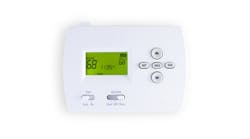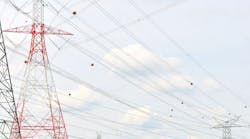From Dec. 25, 2010, to Jan. 10, 2011, several regions of Russian, including the city of Moscow and the surrounding district, were affected by an unusual meteorological event. Freezing rain resulted in a coating of glazed ice on overhead line conductors and towers as well as the crowns of trees located close to the rights-of-way (ROW) through forests. The ice glaze accumulated to a thickness of 25 mm to 30 mm (1 inch to 1.2 inches) in some parts; in the Ulyanovsk and Samara regions, the thickness was 35 mm to 40 mm (1.4 inches to 1.6 inches), exceeding, by a factor of four to seven, the estimated rate of ice accretion for that of previous events.
Under the enormous weight of the ice, tree branches clashed with overhead line conductors, causing ground faults, broken conductors and damaged towers, which led to widespread power outages in the three regions. The aftermath of the freezing rain that damaged thousands of kilometers of power lines and hundreds of towers left some 500,000 residents in the Moscow district without electricity for a long period of time.
Widespread Network Damage
The overall picture of disturbances from this event occurred in the Moscow, Nizhny Novgorod, Smolensk, Tver and Pskov regions. There were three separate occasions, each lasting three hours, when the outages occurred at 133 master substations on the 35-kV and 110-kV networks and 10,330 outages at 10/6-kV transformer substations.
The JSC MOESK distribution utility identified 273,000 fallen and dangerous trees, of which 232,000 were adjacent to the 35-kV to 220-kV overhead lines and 41,000 were adjacent to the 6-kV to 10-kV overhead lines. In total, 38 master substations on the 35-kV and 110-kV network and more than 3,500 10/6-kV transformer substations were temporarily shut down in the Nizhny Novgorod, Smolensk, Tver and Pskov regions. It should be noted the technical breakdowns were restricted to the 110-kV to 6-kV distribution networks.
Russia's United Electric System transmission systems, substations, relay protection and automation systems remained undisturbed throughout this period. According to published data, 470,000 people were without electricity for two to three days while some localities, with severely damaged overhead line feeders, were without power for nearly two weeks. The three peak disturbances and breakdowns occurred during the period when the freezing rain was at maximum intensity.
Breakdown Cause
The main causes of the widespread power outages in the Moscow region were trees falling on power lines and their crowns touching the conducting parts of transmission lines because of the weight of accumulated ice. Ice accretion is caused by anomalous meteorological conditions: sudden warming, long-term super-cooled liquid precipitation (freezing rain), and intensive icing on trees and along overhead lines, conductors and towers. Based on research conducted in the United States, the average time of freezing rain is 2 hours to 4 hours for humid regions, whereas the Russian weather data for freezing rainfall in the Moscow region for this event lasted for 14 hours, exceeding the monthly average rate of adverse weather by four to seven times.
The primary cause of the massive loss of electricity supply was insufficient ROW clearance for power lines routed through forests that belong to a special category of protected forestry in the Moscow region. Long-term discussions about forest usage rules and the requirements of the electrical installation rules had prevented utilities from adequately maintaining the ROW. In August 2011, new legislation was approved that allows adequate ROW to be created and maintained for each voltage class.
To assess the extent of the technical breaches caused by freezing rain, results based on a special analysis of sample data of overhead line outages for the period from 2008 to April 2011, provided by the Eastern Electricity Grid department of MOESK, were examined. The data confirmed the total number of overhead line outages in 2008 and 2009 were similar, whereas the number of outages in 2010 increased by a factor of three. This was caused by falling trees as a result of peat and forest fires in the Moscow district in July 2010 to August 2010, plus the faults due to ice accretion in December 2010.
The former rules for ROW specified 29 m (95.1 ft) for 35-kV to 110-kV overhead lines and 37 m (121.4 ft) for 220-kV overhead lines, but the average height of the trees bordering ROW was at least 25 m (82 ft). When these trees fall, they can damage conductors, ground wires and sometimes even the supporting towers. With insufficient width of ROW, it was difficult to undertake vegetation management, whereas regional officials of the Federal Agency for Forestry Affairs had been raising objections and assessing penalties for the clearance of dangerous trees in the ROW. Now, with the new rules in place for ROW, utilities can maintain adequate clearances.
Since the emergency situation in December 2010 and January 2011, utilities have continued to remove trees, cutting crowns and branches in close proximity to overhead line conductors. They have already removed more than 40,000 trees from the overhead line corridors. To further improve the reliability of supply, there is a planned expansion of the use of insulated conductors for the 1-kV to 35 kV overhead lines.
LiDAR Surveys
Airborne laser survey (ALS) of overhead lines is now widely used by utilities for updating the as-constructed documentation and monitoring the in-service condition of all overhead line components. This includes conductors, ground wires, towers, line insulation and the various buildings and structures located near the ROW.
JSC IDGC Holding regularly requests its 13 regional utilities to employ ALS for infrastructure surveying. Vegetation management is one of the main subjects of these surveys in regions where large areas are covered with forests or other vegetation. For example, some territories in the southern regions of Russia are covered with reeds and cane 3 m to 4 m (9.8 ft to 13.1 ft) tall that can disturb overhead line works during drought and fire-danger periods.
The results of ALS are successfully used to verify the technical condition of overhead lines and vegetation density within power line corridors, as well as to determine the nature of the crop, height and location to within accuracy of 0.01 m (0.4 inches). Alternative methods of overhead line patrolling do not determine the clearances between the conductors and vegetation with such accuracy. Vegetation identified by the ALS in ROW must be removed in accordance with recently approved legislation.
Detecting Damaged Conductors
Tall trees that fall on overhead line conductors in many cases cause short circuits and damage conductors internally and externally. Defects of the outer conductor strands can be easily noted during conventional inspections. To detect internal damaged strands, a nondestructive testing (NDT) device has to be used.
The magnetic head is applied to detect any damage to the steel wire core strands. The eddy current head also is used to determine broken aluminum strands and any decrease in the conductor cross-section. An ongoing program to test the conductors on all spans where trees fell during the winter of 2010/2011 is currently in progress.
Estimating Vegetation Management
The results of ALS to determine vegetation management requirements is used by utilities to determine the type of trees or shrubs to be cleared and the area of the ROW requiring clearance. Information on the area and type of trees and shrubs to be cleared enables maintenance costs to be estimated.
Some of these surveys come back showing the ROW required a large volume of work because between 41% and 75% of the territory was occupied with trees and bushes between 1 m to 10 m (3.38 ft to 32.8 ft) tall, while the specified conductor ground clearance should not be less than 6 m (19.7 ft). This is the reason why vegetation causes phase-to-earth shutdowns especially in summer, when the air temperature rises to 40°C (104°F) and above, and the clearance between conductor and earth or vegetation decreases by between 0.5 m to 0.8 m (1.64 ft to 2.62 ft).
Ground Clearance
Another result of the JSC IDGC Holding overhead line ALS showed a significant number of violations for line specification parameters. The extent of the violations in terms of the conductor to ground clearances on some 110-kV overhead line spans showed 5.5 m (18 ft) of clearance, which was less than the required value of 7 m (23 ft). The excessive conductor sag was caused by creep, which is typical for aluminum conductor steel-reinforced conductors exposed to the mechanical overloading of the freezing rain that caused abnormal conductor elongation.
A Satisfactory Condition
Central Russia experienced a sequence of abnormal weather conditions that started with an anticyclone in the summer 2010 that caused numerous forest and peat fires. In turn, this weakened tree roots, causing instability. This contributed to the aftermath of the freezing rain in December 2010 and again in January 2011, which resulted in serious damage to the overhead line networks in Russian regions, including the Moscow district.
The situational analysis subsequently undertaken confirmed the main contributing cause of the disturbances was the unsatisfactory condition of the overhead line ROW. ALS proved to be a highly effective means for planning vegetation management, offering fast and high-accuracy detection of the ROW requiring clearance. Furthermore, the survey database offers the opportunity for distribution utilities to make an economic appraisal of the measures to restore the ROW for overhead lines to a satisfactory condition.
Acknowledgement
The author would like to acknowledge the technical assistance and support received during the preparation of this article by Vladimir Shkaptsov and Konstantin Konchenko at OPTEN Ltd.
Boris Mekhanoshin ([email protected]) started his career in fiber-optic communications at the Moscow Power Engineering Institute. He then worked for the chair of Radio Transmission Devices and has been involved with fiber-optic technology until he joined ORGRES, where he established the first fiber-optic systems laboratory for the Russian electric power industry. In 1992, he was appointed deputy general director of ORGRES. He was then president and CEO of OPTEN Ltd., a company specializing in design and construction of communication networks and overhead lines. Mekhanoshin joined JSC IDGC Holding in 2010, where he was appointed technical director and deputy general director. He also is an individual member of CIGRÉ.
JSC IDGC Holding
JSC IDGC Holding, a company operating in the electricity sector of the Russian Federation, comprises interregional distribution grid utilities (IDGCs /RDGCs) in addition to a large number of other companies. In total, there are 97 subsidiaries of IDGCs/ RDGCs in 69 constituent entities.
The 13 JSC regions of the holding operations operate the distribution grid that comprises overhead lines at 10 voltage levels from 0.4 kV to 220 kV. The key distribution grid statistics for 2010 indicate an installed substation capacity of more than 401,000 MVA and overhead distribution lines totaling 1,920,584 km (1,194,072 miles), of which 1,508,015 km (937,080 miles) operate in the 0.4-kV to 20-kV voltage range. Hence, IDGC Holding ranks among the world's largest electricity utilities in terms of the length of network and the total population (127.46 million) served in an area of 7.8 million sq km (3.0 million sq miles).
JSC MOESK is the second-smallest JSC region. It supplies the population of 17.143 million living in the city of Moscow and the Moscow region through distribution lines that extend some 148,640 km (92,365 miles).
ROW Width for Overhead Lines with Bare Conductors
Maximum Permissible Current for 110-kV Overhead Lines “TPP 21 - Novobratcevo” in Different Weather Conditions
Companies mentioned:
JSC IDGC Holding www.holding-mrsk.ru
OPTEN Ltd. www.optensolutions.com

